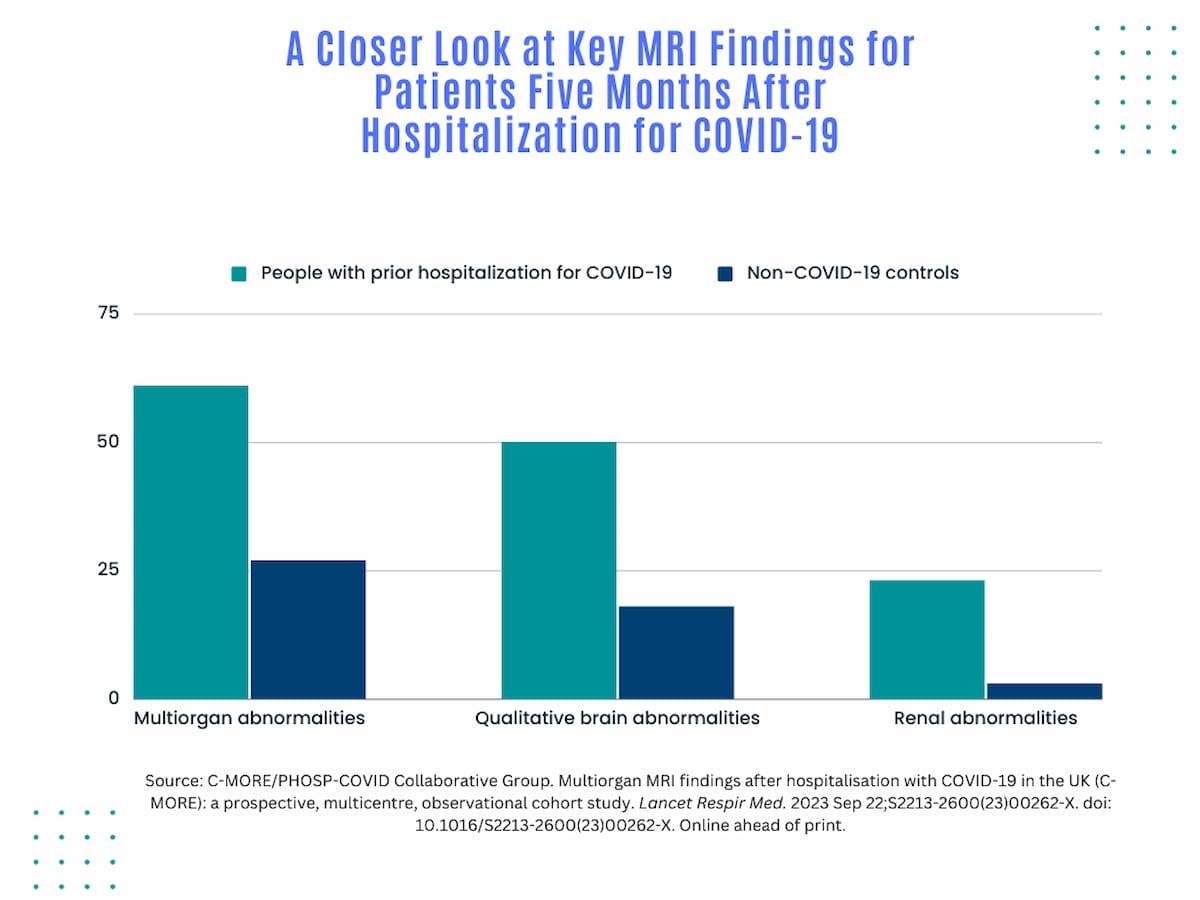Five months after hospitalization for COVID-19, people have a nearly sixfold elevated risk for developing lung abnormalities affecting greater than 5 percent of parenchyma in comparison to non-COVID-19 controls, according to magnetic resonance imaging (MRI) findings from a new study.
For the prospective multicenter study, recently published in Lancet Respiratory Medicine, researchers compared five-month MRI follow-up data for 259 people who had been discharged from hospitals with COVID-19 and 52 people without COVID-19.
The researchers found that 61 percent of the patients with prior hospitalization for COVID-19 had multiorgan abnormalities on MRI in comparison to 27 percent of non-COVID-19 controls. The COVID-19 cohort was 2.9 times more likely to have multiorgan abnormalities, according to the study authors.
“Our study demonstrates the substantial burden of multiorgan abnormalities in patients after (hospitalization) for COVID-19, with nearly one in three patients having an excess burden of multiorgan injury. When compared with controls, we noted a higher proportion of lung, brain and renal MRI abnormalities among patients,” wrote lead study author J.K. Baillie, BSc(Hons), MBChB, PhD, a professor of experimental medicine and co-director of the Baille Gifford Pandemic Science Hub at the University of Edinburgh in the United Kingdom, and colleagues.
While both cohorts had similar percentages of preexisting neurological diagnoses, the study authors said the follow-up MRI data showed that 50 percent of the COVID-19 cohort had qualitative brain abnormalities in comparison to 18 percent of non-COVID-19 controls.
“White matter hyperintensities and small vessel disease were more common among (COVID-19) patients, who also had smaller grey matter volumes relative to controls, specifically in areas important for higher cognitive function … ,” noted Baillie and colleagues
Three Key Takeaways
- Elevated risk of lung abnormalities. Patients hospitalized with COVID-19 have a nearly sixfold elevated risk of developing lung abnormalities affecting more than 5 percent of lung tissue five months after discharge, compared to individuals without COVID-19.
- Multiorgan abnormalities. The study highlights a significant burden of multiorgan abnormalities in COVID-19 patients post-hospitalization. Approximately 61 percent of COVID-19 patients had multiorgan abnormalities on MRI, with higher proportions of abnormalities seen in the lungs, brain, and kidneys.
- Neurological and renal effects. COVID-19 patients exhibited qualitative brain abnormalities, including white matter hyperintensities and small vessel disease, as well as reduced grey matter volumes in areas important for higher cognitive function. Additionally, kidney abnormalities, including decreased renal corticomedullary differentiation, were more prevalent in COVID-19 patients compared to controls.
The MRI findings also revealed that renal abnormalities affected 23 percent of the COVID-19 cohort in comparison to 3 percent of the non-COVID-19 group. Noting that mean renal corticomedullary differentiation is a key marker of renal microstructural health, the study authors pointed out that the COVID-19 cohort had a mean of 371 ms for this measure in comparison to 402 ms in the non-COVID-19 cohort.
(Editor’s note: For related content, see “New Meta-Analysis Details Most Common Brain MRI Findings with COVID-19,” “CT Study Examines Post-Reperfusion Infarction Growth in Vaccine-Naïve Patients with COVID-19” and “Seven Takeaways from New Consensus Recommendations for Cardiac MRI Assessment of COVID-19.”)
In regard to study limitations, the researchers noted the relatively small sample size and inadequate power to assess associations between multiple factors in people with previous hospitalization for COVID-19. Baillie and colleagues also suggested that lung abnormalities may have been underestimated in their study, pointing out that lung MRI lacks the precision of computed tomography (CT) assessment of lung parenchymal abnormalities, and that timing of imaging scans could impact perfusion assessments.

